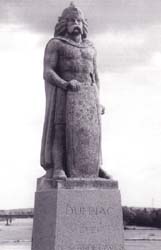
Statue of Dumnacus
Ponts-de-Cé
After a model by David d'Angers
Gauls in Anjou: The Andes or Andécaves
 |
Statue of Dumnacus |
When the Romans came in the first century bce, they found Celts, or Gauls as they called them, a metal-using peoples who mad migrated to the area several centuries before. Loosely organized into tribes, the people inhabiting the area of Anjou were known as the Andes or Andécaves. Their leader was Dumnacus, who joined the famous Vercingétorix in his resistance to Julius Caesar in 52 bce. Dumnacus continued the struggle the next year at Poitiers, when he was forced to retreat across the Loire, presumably at the Ponts-de-Cé where a statue has been erected in his honor. Revolts against the occupying troops are also recorded in 21 and 32 ce, but the Romans were there to stay.
 |
Houses from ca. 80 bce, in Angers |
Archeological excavations have discovered remains of their pre-Roman habitations, these dating to ca 80 bce, a period just before contact. The settlements are usually found on a fortified hilltop or oppidum.
This page was meant to be viewed in frames. |
 Return to Return toAmelia Carr's Home Page |